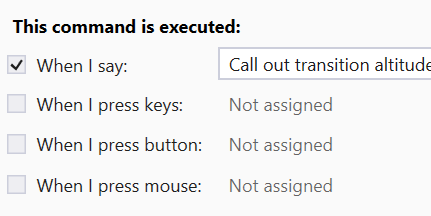Hi there, finally found time to write. I have tested your profiles in flight. I imported them in VA and opened the “ascent command”. After taking a look at the code I understud how it works. Divided in 3 conditions, TA < 10K, TA=10k and TA>10k. It´s quite clear. Before opening the “descent command” I thought it would be the same code with inverted comparators, as we check to be lower than, not higher than, but I saw 8 rows added at the begining of the code that didn´t exist in the other profile. I tryed to understand what do they do, what do they check, and I couldn´t figure it out.
Well, once in the plane, the ascent command works in the 3 different conditions mentioned before, but the descent profile has any problem that I can´t understand. The first time I executed it, it read out instantly “TA reached” and “10 thousand”. THis ha0pened in the same moment I executed the command, at 15 thousand feet. I “erased” those first eight rows that I couldn´t understand their function and tested again. Now the voice anouncements don´t trigger when executing the command. The plane starts descending and I get the anouncements at the expected height. At this point I thought that it was everything ok, but I changed the condition of the test to TA lower that 10k, and when the plane arrived to that height the game crashed. A freezing in the screen and then my windows wallpaper. MSFS had closed itself. I thought it could be some minor thing,opened again and tested it on flight. Ascent command worked perfect, but in descent command another crash of the game. Something is wrong, I prefer to cancell the tests and coment with you the situation before doing anything else.
So I decided to test my profiles. the ones that I posted the other day. I made a correction for resetting the variables and added this four lines at the begining of each command:
Ascent command:__________________Descend command:
Set Boolean [Rta] to false____________Set Boolean [Rtl] to false
Set Boolean [Rten] to false___________Set Boolean [R10] to false
Set Boolean [taN] to false____________Set Boolean [tlN] to false
Set Boolean [tenN] to false___________Set Boolean [10N] to false
Everything works perfect, so by the moment I inserted them in your original profile. When ascending, at TA it sets automatically STD barometre and at 10k turn takeoff lights off. When descending, at 10k turns landing lights on and at TL sets barometer to local QNH (I have a question about this )
Finally I ended with translating strings, erased all the “write to log” lines (I don´t want it to be writting continuosly in the window) and adjusted a couple of processes. For example, the APU on doesn´t waits to be available to continue with the command of after landing flow. The command continues turning off switches and things and when the APU is available it reads it out and ends with the command. Changed a little the order of some flows and checklists, and added inside some checklist a question to me asking to continue with the next flow ( this is made for example in the “before start checklist”). After adjusting everything to my expectations I made two full flights, from cold and dark to again cold and dark in destination airport. Everything worked well, I was very happy because the experience is now much more realistic. Only a couple problems found:
Turning on and off the external power doesn´t work in the corresponding flows. If you trigger the specific command with your voice it works perfect, connects and disconnects it, but when executed trough the flow it doesn´t work. No connect and no disconnect. Tryed several times and no one I see it work. So I cancelled that lines in the flows. Now when you start the plane it goes to turn the APU on without the external power that goes before that in your flow. Another little problem found is that the plugin losts connection with the plane several times. I received various of these messages along the tests:
MSFS: Couldn’t make a connection to WASM, context: A:Indicated_Altitude
MSFS: Retrying connection
MSFS: Couldn’t make a connection to WASM, context: CC: 0 (>L:LANDING_2_Retracted) 1 2 r (>K:2:LANDING_LIGHTS_SET)
MSFS: Retrying connection
MSFS: Couldn’t make a connection to WASM, context: A:Circuit_Switch_On_22
MSFS: Retrying connection
Sometimes this happens when there´s a flow in execution, and it pauses until it reconnects and then continues executting the flow.
And my last question: when you set the altimetre in the “starting the plane command” you use the variable L:XMLVAR_Baro1_Mode. This is made with the plane on ground in the origin airport. As I told, in the “descent monitoring” commnad I execute it again at TL to set the local QNH, but my doubt is: the plane at that point is not stopped on ground, is flying, so where does that variable take the information from? That pressure setted in the baro corresponds to the same pressure in the destination airport. Because if not, the altitude is incorrect, and in an event of autoland the plane would crash agaist the floor. Is there another variable that obtains the barometric pressure of destination airport? Do I need to better change the command and not execute the function of auto setting the QNH and change it only for a voice anouncement and set it manually by myself?
Basically this is all by the moment.
![]()

